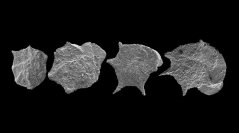

 Comptes Rendus Palevol
7 (4) - Pages 195-203
Comptes Rendus Palevol
7 (4) - Pages 195-203Microproblematica from the Campanian–Maastrichtian boundary stratotype (Tercis, France) include the continuously evolving genus Aturella, short-living taxa, and widely distributed taxa. The same is true in the immediate vicinity as well as in the southern Pyrénées, 100 km apart. These newly established microfossils allow the most precise regional biostratigraphical correlations. Amongst contemporaneous foraminifera, Radotruncana calcarata was collected from seven sections from the platform and flysch facies where it was formerly unknown or poorly known. Regionally, this foraminifer is the most precise foraminiferal marker of the end of the Cretaceous, as it was already elsewhere in the world. Absent from the flysch facies, the microproblematica are restricted to the pithonellid-rich platform facies.
Biostratigraphy, Microproblematica, Gilianelles, Radotruncana calcarata, Campanian, Pyrenees